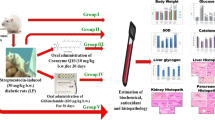Abstract
Although coenzyme Q10 (CoQ10) is a component of the oxidative phosphorylation process in mitochondria that converts the energy in carbohydrates and fatty acids into ATP to drive cellular machinery and synthesis, its effect in type I diabetes is not clear. We have studied the effect of 4 wk of treatment with CoQ10 (10 mg/kg, ip, daily) in streptozotocin (STZ)-induced (40 mg/kg, iv in adult rats) type I diabetes rat models. Treatment with CoQ10 produced a significant decrease in elevated levels of glucose, cholesterol, triglycerides, very-low-density lipoprotein, lowdensity lipoprotein, and atherogenic index and increased high-density lipoprotein cholesterol levels in diabetic rats. CoQ10 treatment significantly decreased the area under the curve over 120 min for glucose in diabetic rats, without affecting serum insulin levels and the area under the curve over 120 min for insulin in diabetic rats. CoQ10 treatment also reduced lipid peroxidation and increased antioxidant parameters like superoxide dismutase, catalase, and glutathione in the liver homogenates of diabetic rats. CoQ10 also lowered the elevated blood pressure in diabetic rats. In conclusion, CoQ10 treatment significantly improved deranged carbohydrate and lipid metabolism of experimental chemically induced diabetes in rats. The mechanism of its beneficial effect appears to be its antioxidant property.
Similar content being viewed by others
References
M. Brownlee, Biochemistry and molecular cell biology of diabetic complications, Nature 414, 813–820 (2001).
M. Brownlee, Negative consequence of glycation, Metabolism 49, 9–13 (2000).
P. Rosen, P. P. Nawroth, G. King, et al., The role of oxidative stress in the onset and progression of diabetes and its complications: a summary of a congress series sponsored by UNESCO-MCBN, the American Diabetic Association, and the German diabetic society, Diabetes 17, 189–212 (2001).
I. C. West, Radicals and oxidative stress in diabetes, Diabetes Med. 17, 171–180 (2000).
D. Giuglian, A. Ceriello, and G. Paolisso, Diabetes mellitus, hypertension and cardiovascular disease. Which role for oxidative stress? Metabolism 44, 363–368 (1995).
A. K. Mohamed, A. Bierhaus, S. Schiekofer, et al., The role of oxidative stress and NFκB activation in late diabetic complications, Biofactors 10, 157–167 (1999).
C. D. A. Stehouwer and N. C. Schaper, The pathogenesis of vascular complications of diabetes mellitus. One voice or many? Eur. J. Clin. Invest. 26, 533–543 (1996).
M. Yaqoob, A. W. Patrick, P. McClelland, et al., Relationship between markers of endothelial dysfunction, oxidant injury and tubular damage in patients with insulin-dependent diabetes mellitus, Clin. Sci. 85, 557–562 (1993).
S. R. Maxwell and H. Thomson, Antioxidant status in patients with uncomplicated insulin-dependent and non-insulin-dependent diabetes, mellitus, Eur. J. Clin. Invest. 27, 484–490 (1997).
S. A. Santini and G. Marra, Defective plasma antioxidant defenses and enhanced susceptibility to lipid peroxidation in uncomplicated IDDM, Diabetes 46, 1853–1858 (1997).
L. ErnsteerL and G. Dallner, Biochemical, physiological and medical aspects of ubiquinone function, Biochem. Biophys. Acta. 1271, 195–204 (1995).
J. Kucharska, Z. Braunova, I. O.uliena, et al., Deficit of coenzyme Q10 in heart and liver mitochondria of rats with Streptozotocin induced diabetes, Physiol. Res. 49, 411–418 (2000).
R. Stocker and B. Frei, Endogenous antioxidant defenses in human blood plasma, in Oxidants and Antioxidants, H. Sies, ed., Academic, London, pp. 213–243 (1991).
H. Ohkawa, N. Ohis, and K. Yagi, Assay of lipid peroxides in animal tissues by thiobarbituric reaction, Anal. Biochem. 95 351 (1979).
H. Mishra, and I. Frodvich, The role of superoxide anion in the autoxidation of epinephrine and a simple assay for superoxide dismutase, J. Biol. Chem. 247, 31–70 (1972).
H. Aebi, Catalase in vitro. Methods in Enzymology, L. Packer, ed., Academic, New York Vol. 105, p. 121–126 (1984).
E. Beutler and B. Kelly, The effect of sodium on RBC glutathione, J. Experimentia 19, 96 (1963).
O. Lowery, N. Rosenbrough, A. Farr, et al., Protein measurement with the folin phenol reagent, J. Biol. Chem. 193, 265 (1951).
R. Stocker and B. Frei, Endogenous antioxidant defenses in human blood plasma, in Oxidative Stress: Oxidants and Antioxidants, H. Sies, ed., Academic, London, pp. 213–243 (1991).
B. Rodrigues, R. K. Goyal, and J. H. McNeill, Effect of hydralazine on STZ-induced diabetic rats: prevention of hyerlipidenia and improvement in cardiac function, J. Pharmacol. Exp. Ther. 237, 292–299 (1986).
R. B. Singh, S. N. Shinde, R. K. Chopra, et al., Effect of CoQ10 on experimental atherosclerosis and chemical composition and quality of atheroma in rabbits, Atherosclerosis 148, 275–282 (2000).
H. Esterbauer, J. Gebicki, and G. Jurgens, The role of lipid peroxidation and antioxidants in oxidative modification of LDL, Free Radical Biol. Med. 13, 341–390 (1992).
S. M. Lynch, J. D. Morrow, L. J. Roberts, et al., Formation of non-cyclo oxygenase derived prostanoids, (F2-isoprostares) in plasma and low-density lipoprotein exposed to oxidative stress in vivo, J. Clin. Invest. 93, 998–1004 (1994).
A. Rabinovitch, W. L. Suarez-Pinzon, K. Strynadka, et al., Human pancreatic islet β-cell destruction by cytokines involves oxygen free radicals and aldehyde production, J. Clin. Endocri. Metab. 81, 3197–3202 (1996).
J. Ludvigsson, Intervention at diagnosis of type I diabetes using antoxidants of photopheresis, Diabetes Metab. Rev. 9, 329–336 (1993).
S. Suzuki, Y. Hinkio, and K. Komatu, Oxidative dasmage to mitochondrial DNA and its relationship to diabetes complications, Diabetes Res. Clin. Pract. 45, 161–168 (1999).
D. Steinberg, S. Parthasarathy, T. E. Carew, et al., Beyond cholesterol: modification of low-density lipoprotein that increase to atherogenicity, N. Engl. J. Med. 320, 915–924 (1989).
P. T. Shih, M. J. Elices, Z. T. Fang, et al., Minimally, modified low density lipoprotein induces monocyte adhesion to endothelial connecting segment I by activating B1-integrin, J. Clin. Invest. 103, 613–625 (1999).
R. B. Singh, M. A. Niaz, S. S. Rastogi, et al., Effect of hydrosoluble CoQ10 on blood pressure and insulin resistance in hypertensive patients with coronary artery disease, J. Hum. Hypertens. 13, 203–208 (1999).
Author information
Authors and Affiliations
Rights and permissions
About this article
Cite this article
Modi, K., Santani, D.D., Goyal, R.K. et al. Effect of coenzyme Q10 on catalase activity and other antioxidant parameters in streptozotocin-induced diabetic rats. Biol Trace Elem Res 109, 25–33 (2006). https://doi.org/10.1385/BTER:109:1:025
Received:
Accepted:
Issue Date:
DOI: https://doi.org/10.1385/BTER:109:1:025




